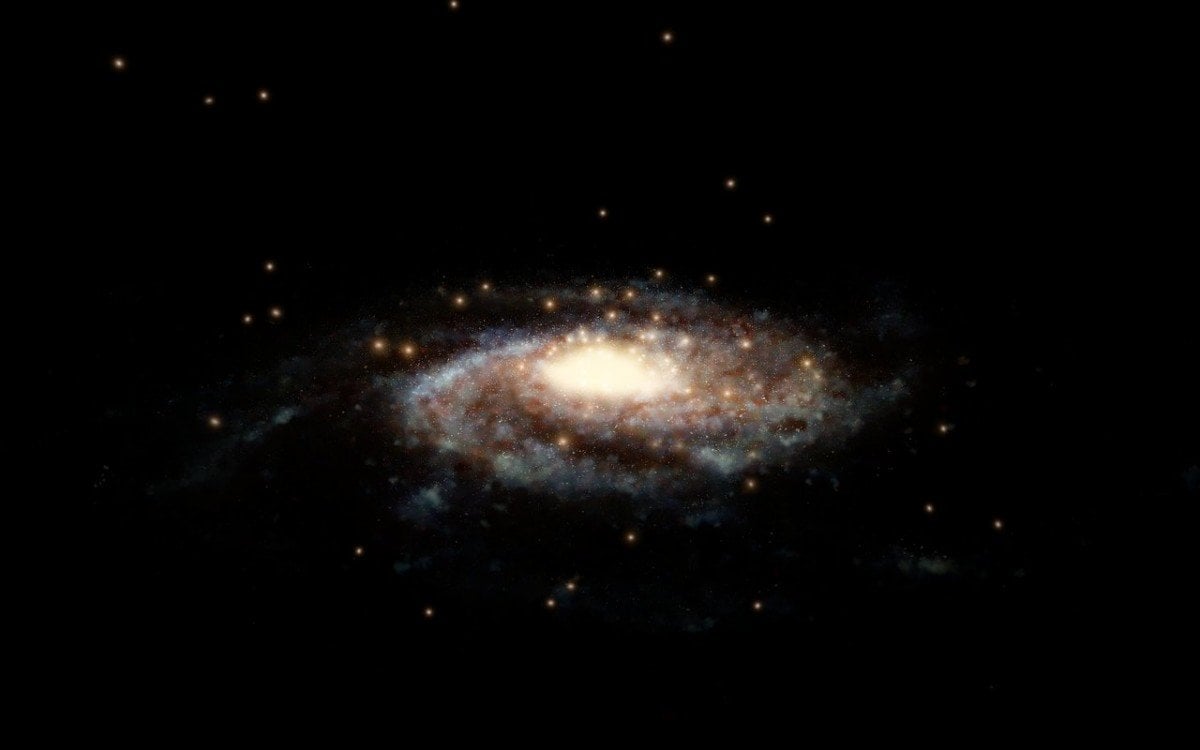
How do you weigh a galaxy and how much does such a galaxy weigh anyway? An international team of astronomers from the European Southern Observatory (ESO) in Garching near Munich, the British University of Cambridge, the Johns Hopkins University Center for Astrophysical Sciences, and the Space Telescope Science Institute in Baltimore, USA could at least approximately determine the weight of the Milky Way. To achieve that, they combined new data from the ESA Gaia mission with observations made with the NASA/ESA Hubble Space Telescope.
The result was that our home galaxy weighs around 1.5 trillion solar masses within a radius of 129,000 light years around the galactic center. “1.5 trillion solar masses is 3 x 10^39 tons. That’s a 3 with 39 zeros after it or 3 000 000 000 000 000 000 000 000 000 000 000 000 000 tons!” says team leader Dr. Laura Watkins of ESO.
Previous estimates of the mass of the Milky Way ranged between 500 billion and 3 trillion times the mass of the Sun. This large difference is primarily due to the different methods used for measuring the distribution of dark matter — which makes up about 90% of the mass of the galaxy. “We just can’t detect dark matter directly,” explains Laura Watkins (European Southern Observatory, Germany), who led the team performing the analysis. “That’s what leads to the present uncertainty in the Milky Way’s mass — you can’t measure accurately what you can’t see!”
Since dark matter cannot be measured and therefore not weighed, researchers use other methods. They measured the velocity of globular clusters – dense star clusters that orbit the spiral disc of the galaxy at great distances.

Star clusters as measuring points
“We use the motions of a group of objects to measure the mass of the larger object. The objects (in this case globular clusters) orbit inside a larger object (in this case the Milky Way). The clusters move under the force of gravity from the Milky Way,” explains Laura Watkins. “How fast they move depends on the size of the gravitational force, which depends on how much mass there is. So to turn this around, by measuring their speeds, we can estimate the mass of the Milky Way. We use the clusters to estimate the mass of the Milky Way, not the mass of the clusters themselves.”
The researchers based their study on data collected by Gaia, an ESA (European Space Agency) satellite designed to create a precise three-dimensional map of astronomical objects throughout the Milky Way and to track their motions. The second data release includes measurements of globular clusters as far as 65,000 light-years from Earth.
The team combined these data with Hubble’s observations, which allowed them to include faint globular clusters up to 130,000 light years from Earth. Since Hubble has been observing some of these objects for ten years, it was also possible to accurately track the velocities of these clusters as well.
However, the weight of individual objects such as planets or stars is not determined in this way. “With this method, we can measure the total mass of everything inside the Milky Way (the dark matter, gas, stars, planets, black holes), all added together. The clusters move because they feel a gravitational force — they only know the total force they feel, not how much of that force came from one type of object and how much came from another. So we can’t estimate the mass of individual things with this method, only the Milky Way’s total mass,” explains Laura Watkins.

NGC 4147 is located about 60 000 light-years from Earth in the northern constellation of Coma Berenices (the Berenice’s hair). © ESA/Hubble & NASA, T. Sohn et al.
Huge significance for science
Until now, the lack of information about the exact mass of the Milky Way has been a problem for attempts to answer a lot of cosmological questions. The dark matter content of a galaxy and its distribution are intrinsically linked to the formation and growth of structures in the Universe. ” “From other research, we know that total mass of the stars in the Milky Way is about 60 billion solar masses (so around 4% of the total mass we found),” adds Watkins. “We also know that the total mass in baryons (stars and gas) is around 16%. If 4% is in stars, then 12% must be gas. The remaining 84% is dark matter.”
Therefore, this result also has a huge significance for science, the astronomer emphasizes. “The Milky Way is the closest galaxy to us so it is the one we can study in most detail. Astronomers use the knowledge we can get of the Milky Way to learn about more distant galaxies that we can’t study in such detail. So knowing a fundamental quantity like the mass of the Milky Way helps us understand how it compares to other galaxies.”
These findings would also help us understand the history and future of the Milky Way. “We see the Milky Way as it is now, not as it was in the past,” Watkins says. “So astronomers make simulations of how the Milky Way might have formed and evolved over billions of years and then look to see which simulations end with a galaxy looks most like the Milky Way. To do these comparisons, we need to know the properties of the Milky Way as accurately as possible.”
You might also like:
ESO’s VLT Shows Bubbles of Brand New Stars
Hubble discovers the brightest quasar in the early universe
Einstein’s general theory of relativity successfully tested by ESO
Hubble finds more evidence for moon outside our solar system








